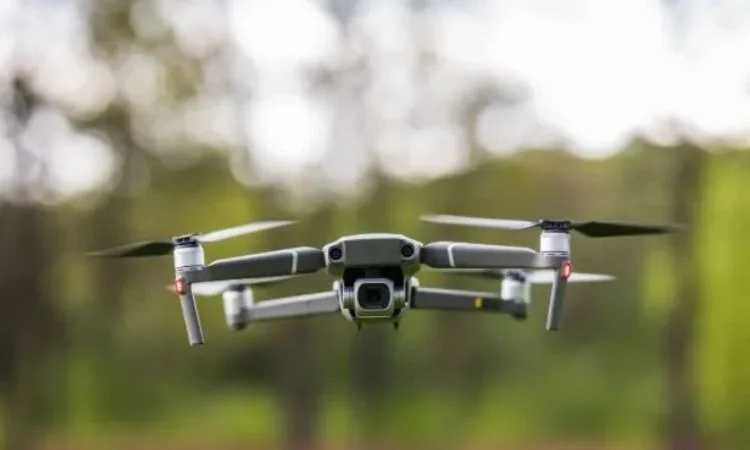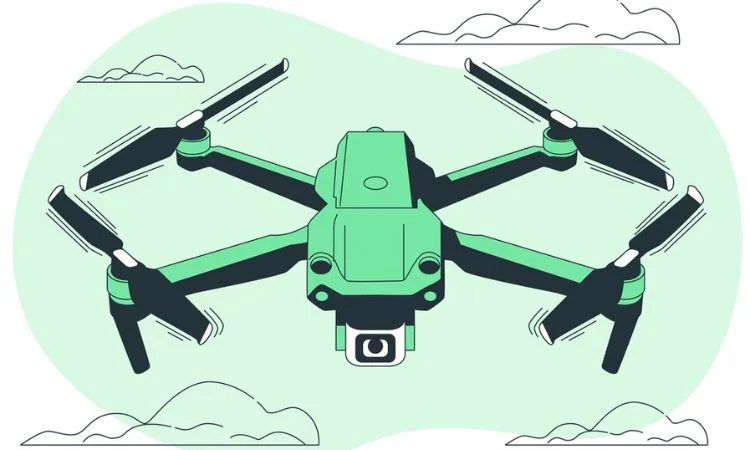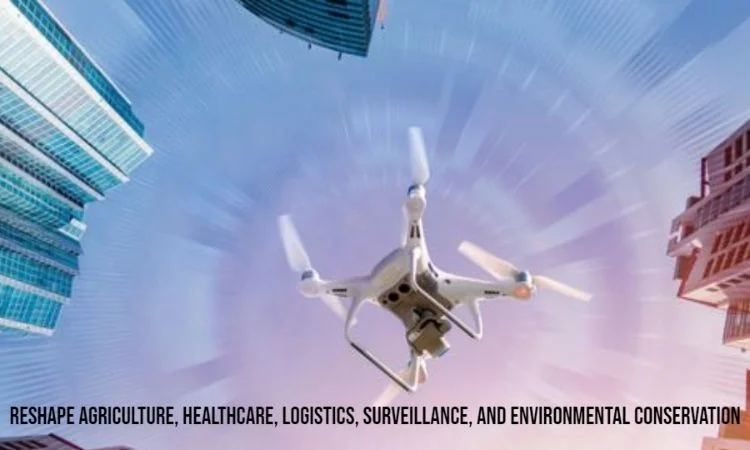The Indian airspace is currently undergoing a transformative revolution, characterized not by fighter jets but by the proliferation of agile and buzzing drones.
Unmanned Aerial Vehicles (UAVs), commonly known as drones, have emerged as versatile tools utilized by numerous countries to address diverse challenges such as disease control, environmental cleanup, and innovative delivery services like pizza. The inherent benefits of remote access and enhanced safety offered by drones have spurred a consistent expansion of their applications across various industries.

The emergence of Indian drone startups is reshaping various industries, introducing a heightened level of efficiency, precision, and innovation into sectors that have traditionally adhered to conventional methods.
Even in India, a nation steadily advancing in technological domains such as electric vehicles, digitization, and artificial intelligence, there is a growing recognition of the utility of drones across various sectors. Initially employed in defense, photography, and video recording, drones are now playing pivotal roles in areas such as food delivery, surveillance, geographical mapping, disaster management, search and rescue operations, among others
The Government of India envisions positioning the nation as a Global Drone Hub by the year 2030.
The Expanding Landscape of the Indian Drones Market
The drone market in India, originally employed for defense purposes, has experienced significant expansion, now encompassing a diverse array of applications, including the transportation of vaccinations, medical supplies, electronic devices, and essential commodities such as food and groceries.
According to the Civil Aviation Ministry, the Indian drones industry is poised to achieve a substantial market valuation of US$ 1.5-1.9 billion by the year 2026.
This remarkable growth is attributed to several key factors:
Government Initiatives: The government is actively contributing to the expansion of the drone industry, aiming to generate over 10,000 jobs and stimulate Micro, Small, and Medium Enterprises (MSME) investments. This is facilitated by the simplification of eligibility criteria for the Production-Linked Incentive (PLI) scheme for Drones and Drone Components. Additionally, liberalized policies have been implemented to empower individuals and businesses to harness the potential of drone technology.
Entrepreneurial Interest: The sector has witnessed a substantial surge in interest from both startups and established corporations. Between August 2021 and February 2022, the number of drone startups in India grew by 34.4%, reaching a total of 221.
Research and Development: A significant driver of the industry’s growth is the flourishing landscape of research and development. Since 2015, drone companies have filed approximately 37 patents related to technologies such as propeller safety in automated aerial vehicles, highlighting a commitment to innovation and safety within the sector.
India’s Drone Revolution : Takes Flight with Pioneering Companies and Startups

Numerous companies and startups have emerged, providing a diverse range of services across various industries.
A Bengaluru-based Drones as a Service (DaaS) provider, specializing in ‘pay per use’ drone services catering to agriculture, survey/mapping, surveillance, and inspection applications.
A Chennai-based DaaS startup is dedicated to empowering Indian farmers and the agriculture industry. Their ambitious goal involves deploying 6 lakh drones across 6 lakh villages in India by the year 2025.
Another Bengaluru-based startup focuses on delivering business intelligence services to assist companies in their scaling endeavors.
According to a comprehensive EY-FICCI report, the estimated manufacturing potential of drones and their components in India is projected to reach approximately US$ 23 billion by 2030. The report emphasizes promising opportunities for localizing key components such as batteries, airframes, and motors.
Recognized entities like Info Edge Ltd, Rattanindia Enterprises, and Hindustan Aeronautics Ltd are actively pursuing a footprint in the drone manufacturing sector. Furthermore, Zomato, a prominent player in the food delivery industry, recently acquired TechEagle, a Lucknow-based startup, signaling its entry into drone-based food delivery services in India. This dynamic landscape underscores the strategic efforts of both established and emerging players to capitalize on the evolving potential of the drone industry.
Overview of Drones and their Types
Unmanned Aerial Vehicles (UAVs), commonly known as drones, represent a category of flying robots that can be remotely controlled or operate autonomously through software-controlled flight plans integrated with sensors and a Global Positioning System (GPS). This article delves into the technology behind UAVs and explores various types designed to cater to specific purposes and requirements.
Types of Drones:
Multi-Rotor Drones:
Multi-Rotor drones are a cost-effective and easily accessible option. These drones feature multiple motors, such as tricopters (3 rotors), quadcopters (4 rotors), hexacopters (6 rotors), and octacopters (8 rotors). Primarily utilized for aerial inspections and photography, these drones offer versatility and stability.
Fixed-Wing Drones:
Energy-efficient Fixed-Wing drones possess a single rigid wing resembling an airplane design. Unlike multi-rotor counterparts, these drones only require energy for forward motion, making them suitable for applications such as Aerial Mapping, Surveys, Agriculture, and Construction purposes.
Single-Rotor Drones:
Characterized by their robust and helicopter-like structure, Single-Rotor drones consist of a single large spinning wing and a tail rotor for directional control and stability. These drones excel in carrying heavy payloads and are commonly employed for surveying purposes.
Fixed-Wing Hybrid VTOL:
Representing a futuristic design, Fixed-Wing Hybrid VTOL drones combine fixed-wing and rotor-based elements. Equipped with rotors attached to fixed wings, these drones can hover, take off, and land vertically. This unique design makes them ideal for delivery purposes, showcasing innovation in drone technology.
Indian Drone Startups: Reshape Agriculture, Healthcare, Logistics, Surveillance, and Environmental Conservation
In diverse sectors ranging from agriculture to healthcare, logistics to surveillance, Indian drone startups are spearheading transformative initiatives that redefine operational paradigms for businesses.

1. Precision Farming in Agriculture:
Indian drone startups are making a substantial impact in the agricultural sector, particularly through precision farming. Employing advanced imaging technology, drones facilitate the monitoring of crop health, assessment of soil conditions, and optimization of irrigation processes. This has resulted in the emergence of precision farming, enabling more effective resource allocation, heightened yields, and a diminished environmental footprint. Pioneering startups such as Skymet and Asteria Aerospace are leading the charge in this agricultural revolution, providing farmers with invaluable data-driven insights.
2. Healthcare Lifesavers:
In remote and challenging-to-access areas, the integration of drones in healthcare is revolutionizing the delivery of medical supplies. Overcoming infrastructure obstacles, drone startups are ensuring the swift delivery of essential medicines, vaccines, and even conducting medical surveys in remote regions. Zipline, a California-based company with a presence in India, stands out as a trailblazer in using drones for medical deliveries, showcasing the potential of this technology to save lives by offering rapid and reliable healthcare solutions.
3. Logistics Redefined:
Major e-commerce players in India are actively exploring drone technology to enhance the speed and efficiency of delivery services. Aerial deliveries hold the promise of revolutionizing the logistics industry by reducing delivery times and costs. Startups like TechEagle and Skye Air Mobility are diligently working towards establishing a seamless delivery ecosystem, where drones navigate urban landscapes to deliver packages with unprecedented speed.
4. Surveillance and Security:
Indian drone startups are playing a pivotal role in augmenting surveillance and security measures. Drones equipped with high-resolution cameras and real-time monitoring capabilities are being utilized for crowd control, border surveillance, and disaster management. This technology aids law enforcement agencies in ensuring public safety and responding promptly to emergencies. Companies such as ideaForge are making significant contributions to the development of indigenous drone solutions tailored for security applications.
5. Environmental Monitoring for a Greener Future:
Monitoring and safeguarding the environment have become paramount concerns, and drones are emerging as invaluable tools in this endeavor. Indian startups are deploying drones to track deforestation, monitor wildlife, and assess the impact of climate change. By furnishing real-time data and actionable insights, these drones are assisting environmentalists and policymakers in making informed decisions to protect the planet.
Empowering India’s Drone Industry: Government Initiatives and Policies
To foster the growth of India’s burgeoning drone industry, the government has implemented several strategic policies and initiatives, as outlined below:
Production-Linked Incentive Scheme (PLI):
The government has instituted the Production-Linked Incentive (PLI) scheme, designed to bolster the domestic drone manufacturing sector. Under this scheme, drone manufacturers are eligible for a cumulative incentive of US$ 162 million spanning three fiscal years.
Drone Import Policy:
In a move to promote self-reliance and domestic production, the government, as of February 2022, has imposed restrictions on the import of foreign-made drones. However, the import of drone components is still permitted, fostering a balance between self-sufficiency and technological collaboration.
Drone Shakti Scheme:
Launched in the Budget of 2022, the Drone Shakti scheme aims to facilitate and encourage the utilization of drones as a service through corporate entities. This initiative is aligned with the government’s vision to leverage drone technology for various applications.
Agricultural Drones Monetary Grant Program:
In a bid to modernize agriculture practices, the government has introduced a financial incentive program. For instance, the Agricultural Drones Monetary Grant Program offers substantial subsidies, such as a 75% subsidy of the total cost of an agricultural drone, specifically benefiting Farmers Producers Organizations. This initiative not only promotes the adoption of drone technology in agriculture but also supports the economic interests of farming communities.
Conclusion
The dynamic landscape of Indian drone startups, coupled with robust government support and collaborative efforts with the industry, accentuates the nation’s deliberate endeavors to leverage the evolving potential of the drone industry.
The government is actively pursuing strategic initiatives, exemplified by the Production-Linked Incentive Scheme and the Drone Shakti Scheme. Additionally, the implementation of policies such as restrictions on drone imports and financial incentives for the adoption of agricultural drones underscores a dedicated commitment to nurturing the growth of the domestic drone industry.
With a projected manufacturing potential of drones and components estimated to reach US$ 23 billion by 2030, India is strategically positioning itself as a Global Drone Hub.This collective commitment aims to contribute significantly to a technologically advanced future.















